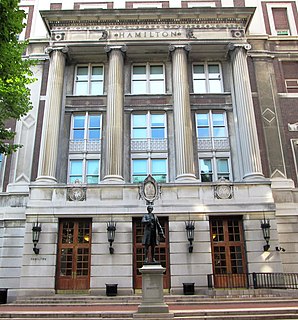
Alexander Hamilton was an American statesman, politician, legal scholar, military commander, lawyer, banker, and economist. He was one of the Founding Fathers of the United States. He was an influential interpreter and promoter of the U.S. Constitution, as well as the founder of the nation's financial system, the Federalist Party, the United States Coast Guard, and the New York Post newspaper. As the first secretary of the treasury, Hamilton was the main author of the economic policies of George Washington's administration. He took the lead in the federal government's funding of the states' debts, as well as establishing the nation's first two de facto central banks, the Bank of North America and the First Bank of the United States, a system of tariffs, and friendly trade relations with Britain. His vision included a strong central government led by a vigorous executive branch, a strong commercial economy, government-controlled banks, support for manufacturing, and a strong military.

The Bank of North America was a private national bank which served as the United States' first de facto central bank. Chartered by the Continental Congress on May 26, 1781, and opened in Philadelphia on January 7, 1782, it was based upon a plan presented by US Superintendent of Finance Robert Morris on May 17, 1781, based on recommendations by Revolutionary era figure Alexander Hamilton. Failing to gain and maintain sufficient long term traction in that role, it was succeeded by the also privately held First Bank of the United States in 1791.

Eric Honeywood Partridge was a New Zealand–British lexicographer of the English language, particularly of its slang. His writing career was interrupted only by his service in the Army Education Corps and the RAF correspondence department during World War II.

The Founding Fathers of the United States, or simply the Founding Fathers or Founders, were a group of American leaders who united the Thirteen Colonies, led the war for independence from Great Britain, and built a frame of government for the new United States of America upon republican principles during the latter decades of the 18th century.

William Ordway Partridge was an American sculptor whose public commissions can be found in New York City and other locations.

The Philolexian Society of Columbia University is one of the oldest college literary and debate societies in the United States, and the oldest student group at Columbia. Founded in 1802, the Society aims to "improve its members in Oratory, Composition and Forensic Discussion." The name Philolexia is Greek for "love of discourse," and the society's motto is the Latin word Surgam, meaning "I shall rise." The society traces its roots to a literary society founded by Alexander Hamilton in the 1770s.

Hamilton Fish II was an American lawyer and politician who served as Speaker of the New York State Assembly and a member of the United States House of Representatives.

Alexander Hamilton Rice was an American politician and businessman from Massachusetts. He served as Mayor of Boston from 1856 to 1857, a U.S. Congressman during the American Civil War, and as the 30th Governor of Massachusetts from 1876–78. He was part owner and president of Rice-Kendall, one of the nation's largest paper products distributors.

Hamilton Hall is an academic building on the Morningside Heights campus of Columbia University on College Walk at 1130 Amsterdam Avenue in Manhattan, New York City. It was built in 1905-1907 and was designed by McKim, Mead & White in the Neoclassical style; the building was part of the firm's original master plan for the campus. The building was the gift of the John Stewart Kennedy, a former trustee of Columbia College, and is named after Alexander Hamilton, who attended King's College, Columbia's original name. A statue of Hamilton by William Ordway Partridge stands outside the building entrance. Hamilton Hall is the location of the Columbia College administrative offices.
Clayton Meeker Hamilton was an American drama critic.
Alexander Hamilton was the first Secretary of the Treasury and one of the Founding Fathers of the United States of America.
Thomas Jefferson (1743–1826) was the third President of the United States.
Colonel Alexander Hamilton Jr. was the third child and the second son of Elizabeth Schuyler and Alexander Hamilton, one of the Founding Fathers of the United States.

Kauffmann Memorial is a public artwork by American artist William Ordway Partridge, located at Rock Creek Cemetery in Washington, D.C., United States. Kauffmann Memorial was originally surveyed as part of the Smithsonian's Save Outdoor Sculpture! survey in 1993. The memorial is a tribute and grave for the former owner of the Washington Star and president of the Corcoran Gallery, Samuel Kauffmann.

The Mayor of Monmouth is an elected position given to a town councillor in Monmouth in Wales. The position dates back about 750 years.
Ordway Tead was an American organizational theorist, adjunct professor of industrial relations at Columbia University, chair of the New York Board of Higher Education, and first president of the Society for Advancement of Management (SAM) in 1936–37.

An outdoor sculpture of Thomas Jefferson by William Ordway Partridge is installed outside the School of Journalism on the Columbia University campus in Manhattan, New York, United States. It was modeled in plaster in 1901 and cast in bronze in 1914 by the New York-based foundry Roman Bronze Works.

Philip Hamilton was the eldest child of Alexander Hamilton, the first U.S. Secretary of the Treasury, and Elizabeth Schuyler Hamilton. He died at age 19, fatally shot in a duel with George Eacker at Weehawken, New Jersey.
William Armistead Moale Burden II was a prominent American banker, art collector, and philanthropist who served as U.S. Ambassador to Belgium under President Eisenhower.














